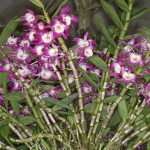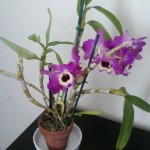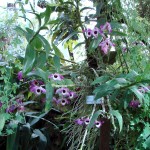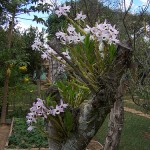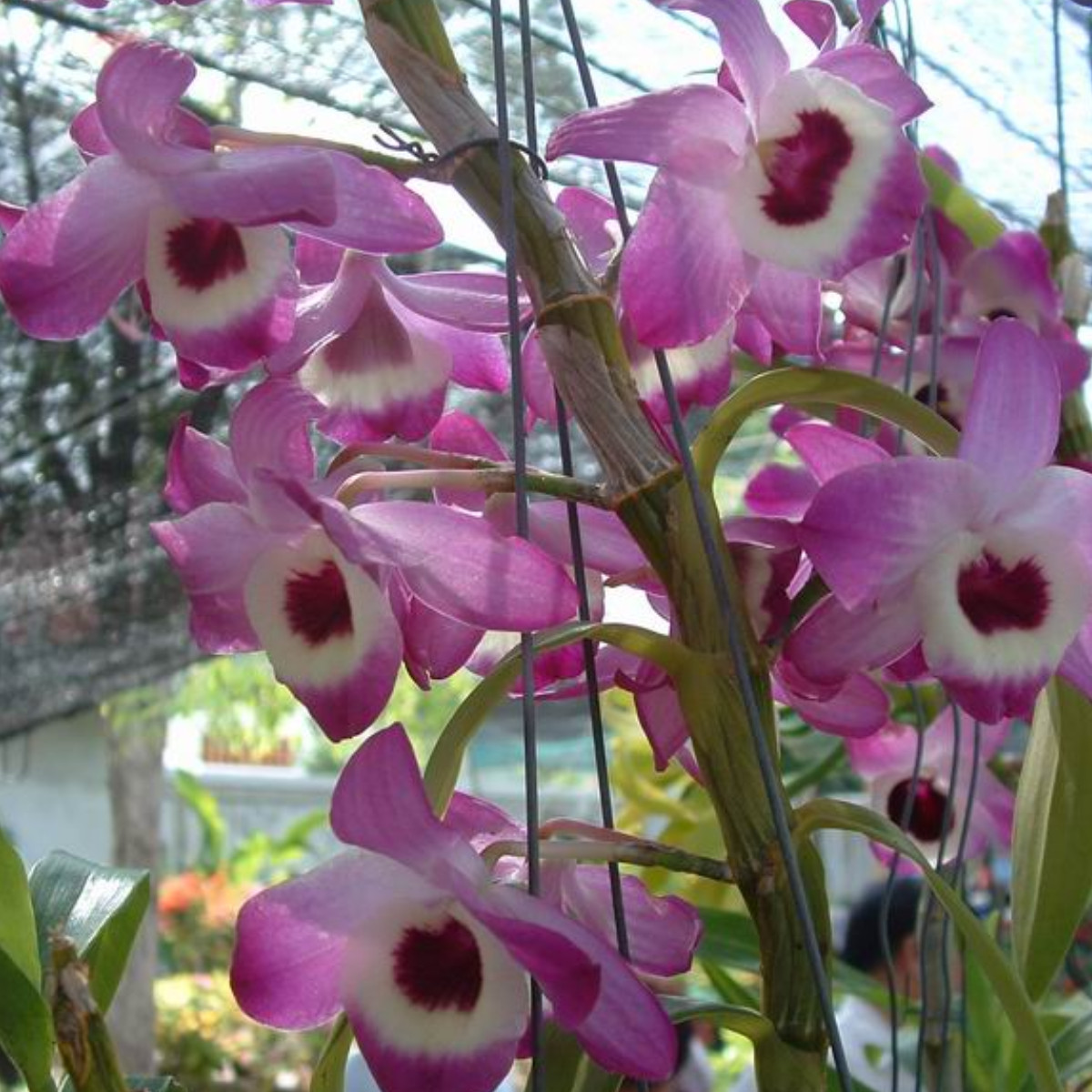Family: Orchidaceae
Distribution and habitat: Dendrobium is a huge genus of orchids, containing about 1,200 species. The genus occurs in diverse habitats throughout much of south, east and southeast Asia, including the Philippines, Borneo, Australia, New Guinea, Solomon Islands and New Zealand. The name is from the Greek dendron ("tree") and bios ("life"); it means "one who lives on trees", or, essentially, "epiphyte". Dendrobium species are either epiphytic, or occasionally lithophytic. They have adapted to a wide variety of habitats, from the high altitudes in the Himalayan mountains to lowland tropical forests and even to the dry climate of the Australian desert.
Dendrobium nobileorchid is one of the most widespread ornamental members of the family.
Description: Dendrobium nobile is a sympodial orchid which forms pseudobulbs. When the life cycle of the mother plant ends it produces little offsets, continuing the life of the plant. The same cycle is used every year. The stem is erect and during the flowering period it forms blooms on its sides along the whole length of the orchid. This monocot has thin, white roots and leads an epiphytic type of life.
Dendrobium nobile has yellows green pseudobulbs up to 1.2m (4 feet) tall, topped with several narrow leaves up to 10cm (4 inch) long and 2cm wide. The leaves are produced in early autumn. In late spring, a pseudobulb that is about to flower lose its leaves and replace them with a branching flower stalks. Each stalk carries two to four flowers up to 8cm (3 inch) across. The petals and sepals have wavy edges. The lip is large and rounded, with a tubular base. Colour varies from lavender to deep purple, but the lip always has a deep maroon blotch in the centre. There are many varieties, some with fragrant flowers.
Houseplant care: Flowers usually should last for two to three months. When in full bloom, flowers will last longer if the plant is placed in a cool, dry spot away from any draft and out of direct sunlight.
Light: Bright light is essential at all times, but filtered strong direct sunlight through a translucent blind or curtain.
Temperature:During the active growth period keep this plant within a temperature range of 15-21C (59-70F) and mist-spray them daily. During the winter rest period keep the Dendrobium nobile at 15-24C (59-75F) during the day and 10-13C (50-55F) at night. Dendrobium nobile can be kept outside in the fall to benefit from the cooler temperatures at night and brought inside just before the onset of freezing weather.
Dendrobium nobiledo best when there is at least a 10-degree difference between daytime and nighttime temperatures.
Watering: From the time flowers buds start to appear and then throughout the active growth period, water the plants moderately, but let the potting mixture dry out nearly completely before watering again. Do not let drops of water rest on new growth, which will root if permitted to stay wet. During the winter rest period give only enough water to prevent the potting mixture from drying out.
Fertilise: During the active growth period only, apply a foliar feed with every third or forth watering.
Potting and repotting: Use any of the potting mixture recommended for orchids. These Dendrobium nobile do best if grown in small conventional pots with plenty of drainage material added. A plant with up to eight pseudobulbs can often thrive in only a 10cm (4 inch) pot. Move the plant to larger pots only when they are overcrowded. This is best done in spring, just as new growth begins.
Propagation: To divide a large plant, cut the rhizome into segments each with at least four pseudobulbs, one of which should not have flowered. Cut away and discard dead, brown pseudobulbs. Plant each segment in an 8cm pot of standard orchid mixture and water it sparingly until new growth appears. Thereafter, treat the young plant as a mature Dendrobium nobile.
Problems: Dendrobium nobile is prone to attack by red spider mites.
Daily mist-spraying may help ward off attack. Cut away badly infested leaves and adjoining stems and spray the plant with an appropriate pesticide.Repeat the treatment after 3 days and again 10 days later. If mites persist, try a different pesticide.
Whichever medium is used, it must be open enough to maintain some air around the roots. The Dendrobium nobile orchid cannot tolerate wet, soggy composts, which will inevitably damage and rot their wiry roots.
Uses:The Dendrobium nobile is the pot plant for decoration because they are more durable than general cut flowers. Dendrobium nobile hybrids make stunning potted plants. Staked upright they look exactly like a living bouquet, with flowers spaced so closely that it becomes hard to see the plant underneath. It is a pleasant decoration not only for living areas, but for offices as well being an easy to care and flowering for long time.
Used as cut flower, the Dendrobium nobile orchids will last for 15 to 60 days in vase.
Dendrobium filters formaldehyde from the air, being a wanted species of houseplants.
SUMMARY:
CHARACTERISTICS:
Foliage green
Features - flowers
Shape upright
Height: 1.2m (4 feet)
PROPER CARE:
Watering in rest period sparingly
Watering in active growth period plentifully
Light bright
Temperature in rest period min 10C max 18C (50-64F)
Temperature in active growth period min 16C max 21C (61-70F)
Humidity high
Hardiness zone: 11
